The Sephardi Community of the Resettlement Era
by Dr Kathrin Pieren, Collections Manager and Curator
The current exhibition
on Jewish people who came to the UK from the Middle East and Northern Africa in
the 20th century – Sephardi Voices – seems a good opportunity to
look at the history of an earlier Sephardi community (people whose ancestry
goes back to Spain, called ‘Sefarad’ in Hebrew). The museum has a
lovely collection of material from the second half of the 17th and the
early 18th century that sheds a light on the life of this small
community.
It was a Sephardi rabbi, Menasseh ben Israel from Amsterdam,
who, in the mid-17th century, pleaded with Oliver Cromwell for the
readmission of Jewish people to the British Isles after they had been expelled
by King Edward I in 1290. Menasseh was looking for a place where Jews could
freely practice their faith, but his plea also had a religious goal.
According
to the messianic beliefs of the time, Jewish settlement in all parts of the
world was a prerequisite for the arrival of the messiah. There were diplomatic
exchanges and a conference was held about the topic, but no conclusive decision
of principle was ever taken.
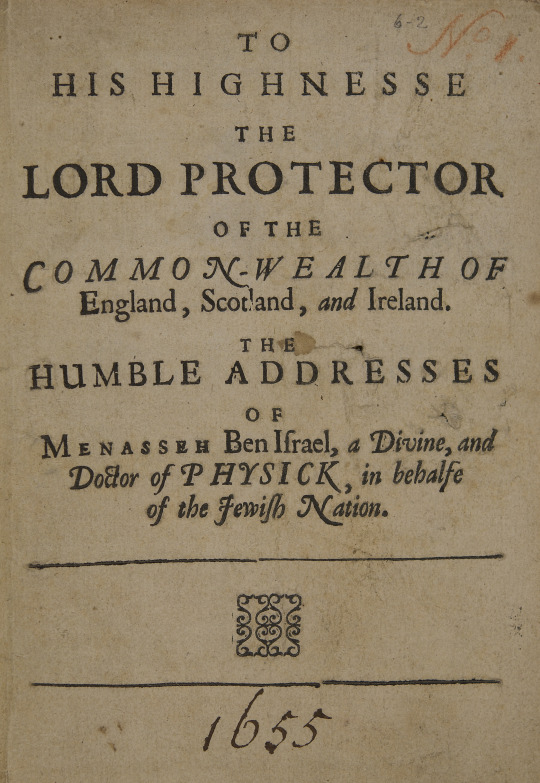
Frontispiece of the Humble
Address by Menasseh Ben Israel, London, 1655
Nevertheless, the tiny Jewish community that had lived as
Christian converts in London at the time, was allowed in 1656 to rent a house
in Creechurch Lane for use as a synagogue and to acquire a plot of land in Mile
End for a cemetery. It appears that Cromwell regarded the settlement of Jewish
traders as economically opportune and, in the Christian version of messianism,
as a religious necessity for the second coming of Christ.
Gradually, Sephardim
from other countries joined the community, and in 1701 it became necessary to
build a larger synagogue in Bevis Marks that seated 400 men and 160 women. This
is the oldest synagogue still in use in Britain today.
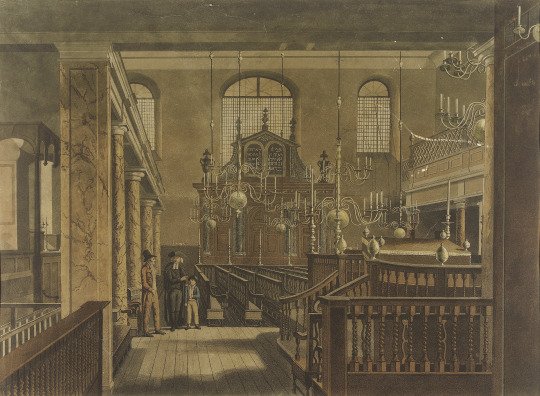
Aquatint of the interior of the Spanish and Portuguese
Synagogue after a watercolour by Isaac Mendes Belisario, 1817. Belisario was
also of Sephardi descent, but he belonged to a later generation. Born in
Kingston, Jamaica in 1795, he came to London with his family at the age of
eight. He is the first documented Jamaican-born artist.
Every year for 100 years starting in 1679 the Bevis Marks congregation
gave a large and beautifully worked silver dish loaded with sweetmeats to the
Lord Mayor of London. This is one of the trays made by John Ruslen, an English
silversmith who also made ritual objects for Bevis Marks for nearly 30 years.
The
dish shows the emblem of the Spanish and Portuguese Synagogue in repoussé
work, a tent in the wilderness with a watcher. Other minority communities, notably
the Dutch Reform and French Protestant churches presented similar items to the
Lord Mayor. The practice hints at the pressure these communities must have felt
to secure the friendship of the Mayor in case of conflict.
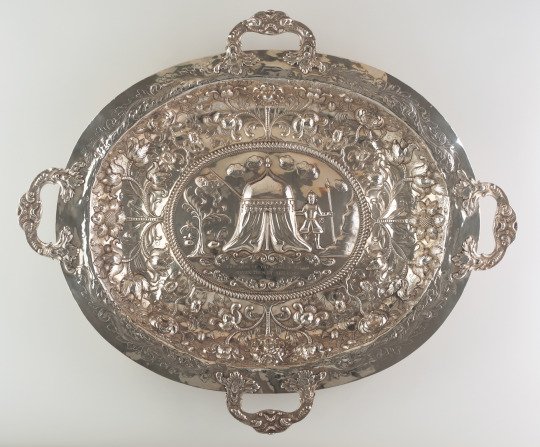
Silver salver by John Ruslen, donated to the Lord Mayor of
London by the Bevis Marks congregation, 1702
Over the half century after their readmission professing
Jews from Holland, the Dutch and English colonies in the Caribbean, and
converts to Christianity from other parts of Europe settled here. By 1695 their
number was 499.
One of the first families that settled were the Mocattas. In
Spain, where the family was from, their members had converted to Catholicism as
this was the only way Jews were allowed to remain in that country during the
time of the Spanish Inquisition.
Yet, when their descendants moved first to
Amsterdam and to London in 1671 they returned to their Jewish faith. In the
early 1700s the family commissioned this exquisite velvet Torah mantle with
gold embroidery and the rimmonim
(Torah finials). The central panel shows a Torah scroll with mantle and rimmonim inside the Holy Ark.
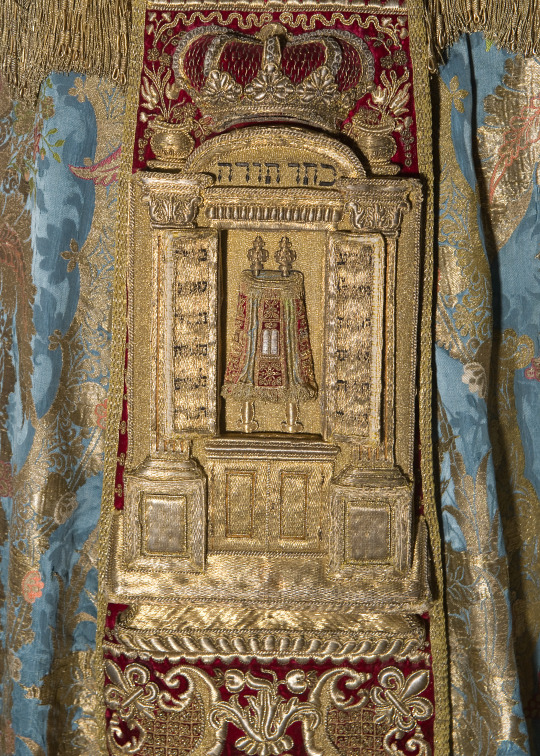
Detail of Torah mantle,
Portugal approx. 1720 (on loan from a private collection)
The small community included overseas merchants, dealers in
precious stones and jewellery, commercial clerks and physicians but also poor
people such as pedlars and servants and those who could cater for the community
including rabbis, kosher butchers and so forth. Soon, the settlers started to
favour English over Spanish and Portuguese, and their adoption of English
habits and fashions was quite smooth.
The family of the painter Catherine Mendes da Costa (1679-1756)
belonged to the local Sephardi community. She is believed to have been the first
British-born Jewish portraitist and the first female Jewish painter in recorded
history. Catherine was a pioneer of watercolour painting on ivory and
specialised in painting her relatives and friends. She produced a pretty locket
portrait of her son Abraham that is now in the Jewish Museum collection.

Locket portrait of Abraham da Costa by his mother Catherine Mendes da Costa, 1714
The Jewish Museum also has several ritual items made by Abraham
Lopes de Oliveyra (1657-1730) who was born in Amsterdam into a Portuguese
Jewish family. As Jews were excluded from the Goldsmiths’ guild in Amsterdam,
he came to London in 1685.
He was employed by the Spanish and Portuguese
Synagogue to clean, set up and repair their ceremonial silver and in 1690, they
bought a silver-gilt Torah pointer from him. Oliveyra made these rimmonim for the Hambro Synagogue, which was an Ashkenazi synagogue set up in 1701.
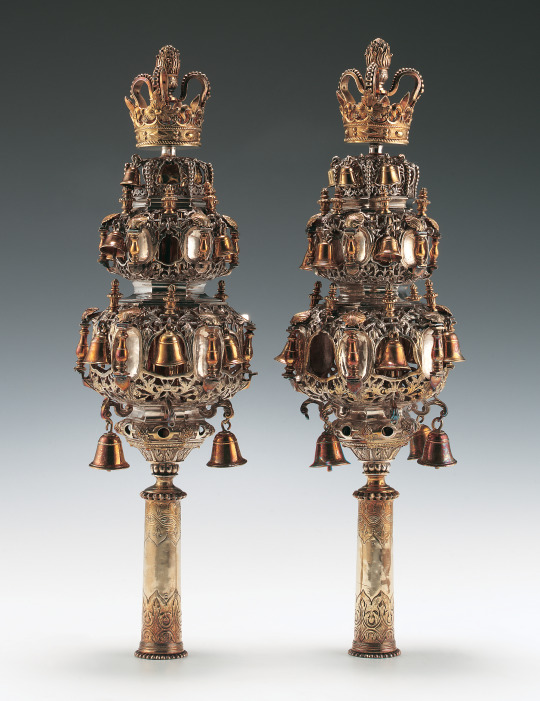
Rimmonim made by Abraham Lopes de Oliveyra for the Hambro Synagogue,
1724 (on loan from the United Synagogue)
While the Sephardi community continued
to grow slowly from the 1700s, Jews from central and Eastern Europe (‘Ashkenaz’
is the Hebrew term for Germany) settled in increasing numbers in England,
including in county towns and seaports. They set up their own institutions and
soon outnumbered the small Sephardi community.